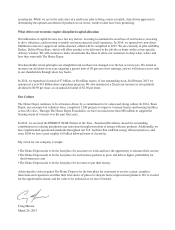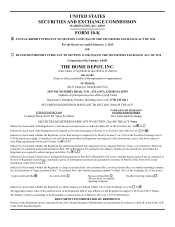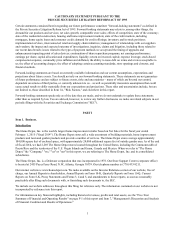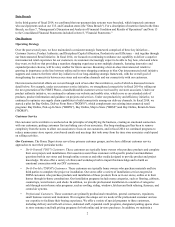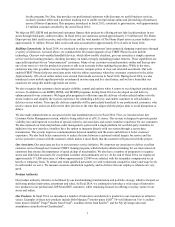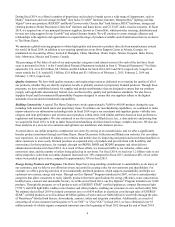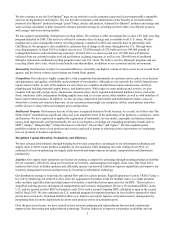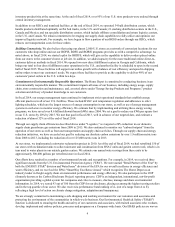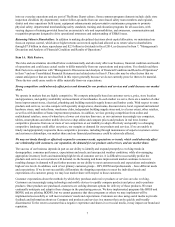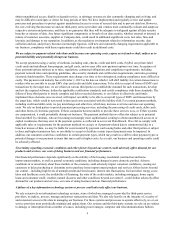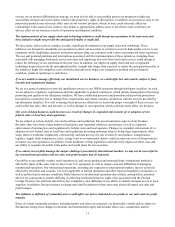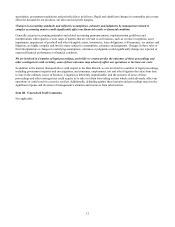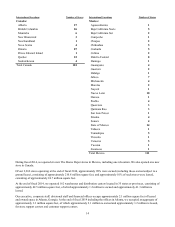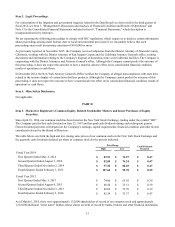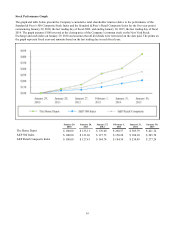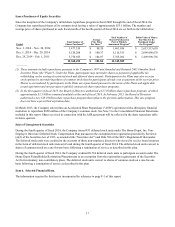Home Depot 2014 Annual Report Download - page 13
Download and view the complete annual report
Please find page 13 of the 2014 Home Depot annual report below. You can navigate through the pages in the report by either clicking on the pages listed below, or by using the keyword search tool below to find specific information within the annual report.8
Further, we have an aging store base that requires maintenance and space reallocation initiatives to deliver the shopping
environment that our customers desire. Failure to maintain our stores and utilize our store space effectively, to provide a
compelling online presence, to timely identify or respond to changing consumer preferences, expectations and home
improvement needs and to differentiate the customer service experience for our three primary customer groups could
adversely affect our relationship with customers, our reputation, the demand for our products and services, and our market
share.
Our success depends upon our ability to attract, train and retain highly qualified associates while also controlling our
labor costs.
Our customers expect a high level of customer service and product knowledge from our associates. To meet the needs and
expectations of our customers, we must attract, train and retain a large number of highly qualified associates while at the
same time controlling labor costs. Our ability to control labor costs is subject to numerous external factors, including
prevailing wage rates and health and other insurance costs, as well as the impact of legislation or regulations governing labor
relations, minimum wage, or healthcare benefits. In addition, we compete with other retail businesses for many of our
associates in hourly positions, and we invest significant resources in training and motivating them to maintain a high level of
job satisfaction. These positions have historically had high turnover rates, which can lead to increased training and retention
costs, particularly if the economy continues to improve and employment opportunities increase. There is no assurance that we
will be able to attract or retain highly qualified associates in the future.
We discovered a data breach in the third quarter of fiscal 2014 and are still in the process of determining the full extent of
its impact and the impact of related government investigations and civil litigation on our results of operations, which
could be material.
Our recent Data Breach involved the theft of certain payment card information and customer email addresses through
unauthorized access to our systems. As a result of the Data Breach, we are facing at least 57 civil lawsuits filed in the U.S.
and Canada, and other claims may be asserted on behalf of customers, payment card brands, payment card issuing banks,
shareholders, or others seeking damages or other related relief, allegedly arising out of the Data Breach. We are also facing
investigations by a number of state and federal agencies. Our financial liability arising from these claims and investigations
will depend on many factors, one of which is whether, at the time of the Data Breach, the portion of our network that handles
payment card data was in compliance with applicable payment card industry standards. Another factor is whether, and if so to
what extent, any fraud losses or other expenses experienced by cardholders, the payment card networks or the card issuing
banks on or with respect to the payment card accounts affected by the Data Breach can be properly attributed to the Data
Breach and whether and to what extent those losses and expenses would in any event be our legal responsibility.
These claims and investigations may adversely affect how we operate our business, divert the attention of management from
the operation of the business and result in additional costs and fines. In addition, the governmental agencies investigating the
Data Breach may seek to impose injunctive relief, which could materially increase our data security costs, adversely impact
how we operate our systems and collect and use customer information, and put us at a competitive disadvantage with other
retailers.
Investigations of the Data Breach are ongoing, and we are still in the process of assessing the financial and other impacts of
the Data Breach. It is possible that we will identify additional information that was accessed or stolen, or other unforeseen
developments related to the Data Breach could occur, which could have a further adverse impact on our operations, financial
results and reputation.
If our efforts to maintain the privacy and security of customer, associate, supplier or Company information are not
successful, we could incur substantial additional costs, and become subject to further litigation, enforcement actions, and
reputational damage.
Our business, like that of most retailers, involves the receipt, storage and transmission of customers' personal information,
consumer preferences and payment card information, as well as confidential information about our associates, our suppliers
and our Company, some of which is entrusted to third-party service providers and vendors. We also work with third-party
service providers and vendors that provide technology, systems and services that we use in connection with the receipt,
storage and transmission of this information. Our information systems, and those of our third-party service providers and
vendors, are vulnerable to an increasing threat of continually evolving cybersecurity risks. Unauthorized parties may attempt
to gain access to these systems or our information through fraud or other means of deceiving our associates, third-party
service providers or vendors. Hardware, software or applications we develop or obtain from third parties may contain defects
in design or manufacture or other problems that could unexpectedly compromise information security. The methods used to


